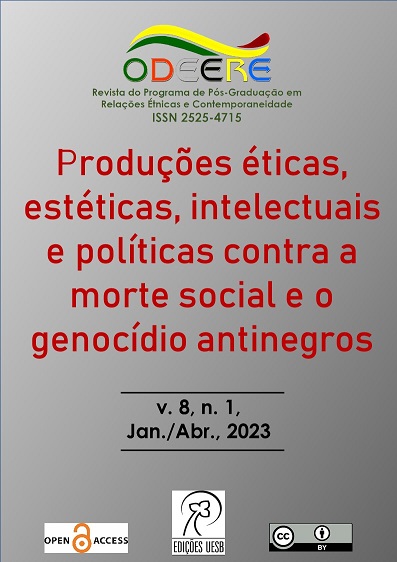Mais que e para-além do racismo: meditações teóricas e políticas sobre antinegritude
DOI:
https://doi.org/10.22481/odeere.v8i1.12274Palavras-chave:
antinegritude, antirracismo, feminismo negro, Combahee River Collective, interseccionalidade, política radical, teoria socialResumo
Este artigo tece considerações sobre antinegritude e a distingue do racismo, expondo a falsa universalidade do Social e do Humano: o racismo ocorre no Social entre os Humanos, enquanto a antinegritude continuamente expulsa os negros e a negritude dessas categorias modernas fundamentais cujas definições derivam da expulsão violenta. Para delinear a discussão, o artigo analisa dois textos paradigmáticos que se esforçam para lidar intransigentemente com a antinegritude, mas através da linguagem do racismo: George Yancey, Who Is White? e "The Combahee River Collective Statement." O artigo conclui sugerindo a necessidade de um salto de invenção fanoniano e uma abrangente abolição.
Downloads
Referências
Brandon Griggs, "Living While Black," CNN.com, December 28, 2018, https://www.cnn.com/2018/12/20/us/living-while-black-police-calls-trnd/ (retrieved January 21, 2021). Some items of the first paragraph are direct quotes, while others are slightly edited.
Hortense Spillers, Black, White, and in Color: Essays on American Literature and Culture (Chicago: University of Chicago Press, 2003), 221.
Dred Scott v. Sanford, 60 U.S. (19 How.) 393 (1857) at 404-405, 417, 420.
Note, too, the concluding phrase, "at their own pleasure." On the law, antiblackness, and pleasure, see Farley (2005).
Moon-Kie Jung, Beneath the Surface of White Supremacy: Denaturalizing U.S. Racisms Past and Present (Stanford, CA: Stanford University Press, 2015), ch. 3.
The notion of "right to have rights" is, of course, Hannah Arendt's (The Origins of Totalitarianism [New York: Harvest, (1951) 1976], 296).
Orlando Patterson, "Preface, 2018," in Slavery and Social Death (Cambridge, MA: Harvard University Press, 2018), ix.
W.E.B. Du Bois, The Philadelphia Negro (Philadelphia: University of Pennsylvania Press, [1899] 1996), 387.
Saidiya V. Hartman, Lose Your Mother: A Journey along the Atlantic Slave Route (New York: Farrar, Straus, and Giroux, 2007), 6; "The Time of Slavery," South Atlantic Quarterly 101:4 (2002): 757.
George Yancey, Who is White? Latinos, Asians, and the New Black/Nonblack Divide (Boulder, CO: Lynne Rienner, 2003); The Combahee River Collective, "The Combahee River Collective Statement," in How We Get Free: Black Feminism and the Combahee River Collective, ed. Keeanga-Yamahtta Taylor (Chicago, IL: Haymarket Books, [1997] 2017), 15-27.
W.E.B. Du Bois, Black Reconstruction (New York: Russell & Russell, 1935). This and the next two paragraphs draw from João H. Costa Vargas and Moon-Kie Jung, "Antiblackness of the Social and the Human," in Antiblackness, ed. Moon-Kie Jung and João H. Costa Vargas (Durham, NC: Duke University Press, 2021), 1-14.
In Logics of History: Social Theory and Social Transformation, William Sewell Jr. distills a lifetime of interdisciplinary work across the social sciences and renders explicit what is usually implicit: "The social is the complex and inescapable ontological ground of our common life as humans" (Chicago, IL: University of Chicago Press, 2005, 369).
On "extreme antisocial situations," see George Steinmetz, "Social Fields, Subfields and Social Spaces at the Scale of Empires: Explaining the Colonial State and Colonial Sociology," Sociological Review Monographs 64:2 (2016): 98-123. We capitalize the Social and, later, the Human to specify their modernity.
Orlando Patterson, Slavery and Social Death: A Comparative Study (Cambridge, MA: Harvard University Press, 1982), 5, 7, 13.
By the modern era, the social death of slavery had become for Europeans "a fate worse than [physical] death and, as such, was reserved for non-Europeans," Africans singularly above all (David Eltis, "Europeans and the Rise and Fall of African Slavery in the Americas: An Interpretation," American Historical Review 98:5 [1993]: 1409).
Hartman, "The Time of Slavery," 757.
Saidiya V. Hartman, Scenes of Subjection: Terror, Slavery, and the Self-Making in Nineteenth-Century America (New York: Oxford University Press, 1997).
Du Bois, The Philadelphia Negro, 386-387.
Saidiya Hartman and Frank Wilderson, "The Position of the Unthought." Qui Parle13:2 (2003):183-201.
Of Scenes of Subjection, Hartman says, "I think of the book as an allegory; its argument is a history of the present." On history of the present, see Michel Foucault, Discipline and Punish: The Birth of the Prison (New York: Pantheon, 1977); David Garland, "What is a 'History of the Present'? On Foucault's Genealogies and Their Critical Preconditions," Punishment & Society 16:4 (2014): 365-384.
On neoslavery, see Douglas A. Blackmon, Slavery by Another Name (New York: Doubleday, 2008).
Vargas and Jung, "Antiblackness of the Social and the Human."
Hartman and Wilderson, "The Position of the Unthought," 192; Hartman, Scenes of Subjection, 206.
bell hooks, We Real Cool: Black Men and Masculinity (London: Routledge, 2004); Howard Winant, The World is a Ghetto: Race and Democracy Since World War II (London, UK: Basic Books., 2002).
Ruth Wilson Gilmore, "Race and Globalization," in Geographies of Global Change: Remapping the World, ed. Ron Johnston, Peter J. Taylor, and Michael Watts (New York: Wiley-Blackwell, 2002): 261; emphasis added.
Ruth Wilson Gilmore, "Fatal Couplings of Power and Difference: Notes on Racism and Geography," The Professional Geographer 54:1 (2002): 16.
Michael Omi and Howard Winant, Racial Formation in the United States (New York: Routledge, 2015), 130.
James Baldwin, "My Dungeon Shook: Letter to My Nephew on the One Hundredth Anniversary of the Emancipation," in James Baldwin: Collected Essays (New York, NY: Library of America, [1962] 1998), 294.
Frantz Fanon, Black Skin, White Masks, trans. Charles Lam Markmann (New York: Grove Press, 1967), 110.
Toni Morrison, The Bluest Eye (New York: Vintage International, [1970] 2007), 48.
Du Bois, The Philadelphia Negro, 386-387.
Yancey, Who Is White?, 83.
Ibid., 72.
Ibid., 10.
Though not discussed here, our critique extends beyond mainstream social theories to all social theories, including the most radical varieties. See Moon-Kie Jung, "The Enslaved, the Worker, and Du Bois's Black Reconstruction: Toward an Underdiscipline of Antisociology," Sociology of Race and Ethnicity 5:2 (2019): 157-168; Vargas and Jung, "Antiblackness of the Social and the Human."
Yancey, Who Is White?, 15.
Ibid., 44, 47.
Ibid., 159.
Spillers, Black, White, and in Color, 221.
Vargas and Jung, "Antiblackness of the Social and the Human."
Robert E. Park, "Our Racial Frontier on the Pacific," The Survey 56:3 (1926): 196.
Jung, Beneath the Surface of White Supremacy, ch. 4; "The Enslaved, the Worker, and Du Bois's Black Reconstruction," 166n25.
Fanon, Black Skin, White Masks, 229; emphasis in original.
James Baldwin, "The American Dream and the American Negro," in James Baldwin: Collected Essays (New York: Library of America, [1965] 1998), 714.
Diane Fujino and Matef Harmachis, eds., Black Power Afterlives: The Enduring Significance of the Black Panther Party (Chicago, IL: Haymarket Books, 2020); Barbara Ransby, Making All Black Lives Matter: Reimagining Freedom in the Twenty-First Century, (Berkeley: University of California Press, 2018); Keeanga-Yamahtta Taylor, ed., How We Get Free: Black Feminism and the Combahee River Collective (Chicago, IL: Haymarket Books, 2017).
In this regard, Demita Frazier, one of the key members of the Combahee River Collective, recounts, "I have to talk to the young woman – Kimberlé Crenshaw...who says that she coined the term intersectionality. I always laugh when I read that because I remember the day we were sitting at the woman's center in Cambridge, drafting our probably third or fourth draft of the statement, I said 'you know, we stand at the intersection where our identities are indivisible.' There is no separation. We are as Black women truly and completely intact in our paradox, and there's nothing paradoxical about oppression" ("Demita Frazier," in How We Get Free: Black Feminism and the Combahee River Collective, ed. Keeanga-Yamahtta Taylor [Chicago, IL: Haymarket Books, (1997) 2017], 123).
"The Combahee River Collective Statement," 15.
We Real Cool, 134.
An End to the Neglect of the Problems of the Negro Woman! (New York: National Women's Commission, Communist Party USA, 1949), 4.
"The Combahee River Collective Statement," 22-23.
Patricia Hill Collins, Black Feminist Thought: Knowledge, Consciousness, and the Politics of Empowerment (New York: Routledge, 1990).
Collins, Black Feminist Thought; Cedric Robinson, Black Marxism: The Making of the Black Radical Tradition (Chapel Hill: University of North Carolina Press, 2000); Satya P. Mohanty, "The Epistemic Status of Cultural Identity: On Beloved and The Postcolonial Condition," in Reclaiming Identity, ed. P.M.L. Moya and M.R. Hames-Garcia (Berkeley: University of California Press, 2000).
"The Combahee River Collective Statement," 15.
"Barbara Smith," in How We Get Free: Black Feminism and the Combahee River Collective, ed. Keeanga-Yamahtta Taylor (Chicago, IL: Haymarket Books, [1997] 2017), 44-45.
Du Bois, Black Reconstruction, 16.
On liberal, radical, and revolutionary Black feminisms, see Joy James, Shadowboxing: Representations of Black Feminist Politics (New York: St. Martin's Press, 1999), 79.
"The Combahee River Collective Statement," 22-23.
Ibid., 19-20.
Ibid., 20, 26, 27.
"Alicia Garza," in How We Get Free: Black Feminism and the Combahee River Collective, ed. Keeanga-Yamahtta Taylor (Chicago, IL: Haymarket Books, 2017), 160-161; emphasis added.
Ibid., 163-164; emphasis in original.
Ibid., 165.
Vargas and Jung, "Antiblackness of the Social and the Human."
Black Skin, White Masks, 229; emphasis in original.
"No Lords A-Leaping: Fanon, C.L.R. James, and the Politics of Invention," Humanities 3 (2014): 518.
Kwame Ture, "Afterword," in Black Power: The Politics of Liberation in America, by Kwame Ture and Charles V. Hamilton (New York, NY: Vintage, 1992).
Scenes of Subjection, 85.
Lélia Gonzalez, "A Categoria Político-cultural de Amefricanidade," Tempo Brasileiro (1988), 69-82; Beth Richie, "Exploring the Link between Violence against Women and Women's Involvement in Illegal Activity," in Research on Women and Girls in the Justice System: Plenary Papers in the 1999 Conference on Criminal Justice Research and Evaluation – Enhancing Policy and Practice through Research (Washington, DC: Department of Justice, 2000), 1-14; Dorothy Roberts, Killing the Black Body: Race, Reproduction, and the Meaning of Liberty (New York, NY: Pantheon Books, 1997); Christina Sharpe, In the Wake: On Blackness and Being (Durham, NC: Duke University Press, 2016).
Ibid.
Patterson, Slavery and Social Death; Joy James, ed., The New Abolitionists: (Neo) Slave Narratives and Contemporary Prison Writings (Albany: State University of New York Press, 2005).
"Black Feminist Theory for the Dead and Dying," Theory & Event 21:1 (2018): 115; emphasis in original.
Frank Wilderson III, "Gramsci's Black Marx: Whither the Slave in Civil Society?," We Write 2(1): 1-17.
Sylvia Wynter and Katherine McKittrick, "Unparalleled Catastrophe for our Species?," in Sylvia Wynter: On Being Human as Praxis, ed. by Katherine McKittrick (Durham, NC: Duke University Press, 2015), 9-89.
Downloads
Publicado
Como Citar
Edição
Seção
Licença
Copyright (c) 2023 ODEERE

Este trabalho está licenciado sob uma licença Creative Commons Attribution 4.0 International License.
Você é livre para:
Compartilhar - copia e redistribui o material em qualquer meio ou formato; Adapte - remixe, transforme e construa a partir do material para qualquer propósito, mesmo comercialmente. Esta licença é aceitável para Obras Culturais Livres. O licenciante não pode revogar essas liberdades, desde que você siga os termos da licença.
Sob os seguintes termos:
Atribuição - você deve dar o crédito apropriado, fornecer um link para a licença e indicar se alguma alteração foi feita. Você pode fazer isso de qualquer maneira razoável, mas não de uma forma que sugira que você ou seu uso seja aprovado pelo licenciante.
Não há restrições adicionais - Você não pode aplicar termos legais ou medidas tecnológicas que restrinjam legalmente outros para fazer qualquer uso permitido pela licença.











